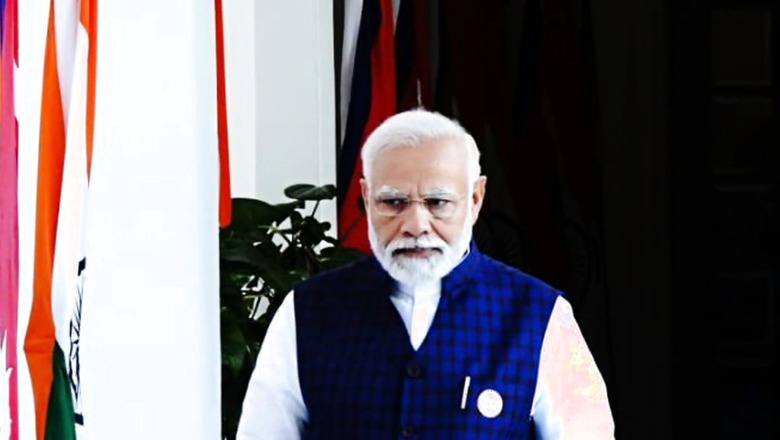
views
In recent days, a simplistic YouTube video about the changing world order by Ray Dalio, a hedge fund manager, is getting ever-increasing eyeballs. This oversimplified video posits that the world order is changing, and a new world order is emerging, explained with simple patterns of the past being repeated currently.
In the extrapolation of the cyclical graphs of the Dutch, British and the US as world powers, which rose and fell over the last few hundred years, the new graph replaces the US with China at the top of the world order. This new world order has several ramifications for India. While not all can be addressed in a single article, this change in perspective will influence every outward-looking policy, from trade to defence.
A simplistic model helps establish a pattern and as the brain takes in the pattern for explanation, such patterns then provide a mental framework for us to explain a complex world and everything in it. More importantly, it establishes a notional fact as reality – as more and more people repeat and believe that, it actually becomes reality. A reality that self-perpetuates, accepted now as common knowledge. The masses having accepted this new reality, political leaders find it very difficult to question it. This new mindset shapes and defines decisions at several levels. It becomes tough to shake this new perception of reality.
Whereas geopolitical power is always in a flux and acceptance or rejection of perception or patterns is what changes it, Putin wants to establish himself as an irrational man who will and can use nuclear or biological weapons in Ukraine. The fear of this irrational action is enough to freeze the whole world into inaction as the world can see a pattern in the past. There have been irrational men in the past, though the atomic bomb was used by a rational man on Japan. The brain likes to fit new information into existing patterns.
Research studies have demonstrated that when people believe that two variables are correlated, they will see a connection even in data where they are totally unrelated. It is not unusual for clinicians to see correlations “in response patterns because they believe they are there, not because they are actually present in the pattern of responses being observed.” (Keith Stanovich, How to Think Straight about Psychology)
The brain is weak at processing logic, remembering facts and making calculations. Its core capabilities are pattern recognition. If there is a deluge of information, as is often the case these days with social media, the easiest way for the brain to accept new information is to put it in a sequence that it will recognise and then remember the pattern. The new pattern that is now being formed in today’s mind is of a new world order. There are several sub patterns that can be formed and established while we are at it.
Changing World Order, Opportunities for India
Now, that these patterns are being established, is there a narrative that India can build to establish that it is also rising as a world power? This is an opportunity for both the foreign ministry and the cultural ministry. Will they align and develop a cultural policy that can help establish this narrative or will they remain restricted to organising events in the name of soft power?
For instance, if there is a change in the world order, is India’s position in the world order also changing? What can we do now to change it? Is there a play here that can be established for the long term? Or will the disinformation sponsored by our walled neighbour, China, overtake the world of narrative.
If nothing else there is a shift in the narrative flow, sponsored or otherwise. Maybe a hedge fund manager is driving the shift from one reserve currency to another, because he has made enough bets on the currency derivatives. Hedge fund managers do not market their content only for the purpose of seeking fame – they have a simple motive to make more money. Even the old Sage of Omaha has often used his pulpit for gains.
A change in the world order because of a war should make us seriously evaluate the threats that we face on our borders. Two of our neighbours are collapsing, one economically and the other politically. Flux is always an important pivot in regional foreign policy in a multi-polar world. Bring Sri Lanka closer by helping them link their rapidly falling currency with India’s central bank digital currency (CBDC)? Help their banking system by allowing Indian banks to acquire them? Sign a new free trade agreement (FTA)? A new playbook is needed as war or conflicts such as in Ukraine will be more frequent.
India’s CBDC and Space for Alternate Currency
The war in Ukraine is not ending, the information flow is unlikely to change. Will the war veer towards a world war, is a question on everybody’s mind. As it helps reinforce another pattern, if there have been two world wars, there has to be a third. Difficult to push a logical argument here when everyone in the world is busy seeing parallels between the last two wars. Will this self-perpetuating pattern actually think us into the third world war?
This is the danger with self-perpetuating patterns: the perception of a pattern emerging makes it happen if enough people believe in it. For instance, if enough people believe that the American dollar’s role as a reserve currency is over, countries will start keeping their reserves in other currencies. Dalio’s video would have played a role in it. Either you play with the narrative or be a contrarian.
There is a role for a sub-narrative here in the reserve currency world and I had written about how India’s CBDC stack can play a role here. India cannot change the world order, but it can certainly play to its strengths in the world order. It should not matter who is number one or number two to India. What matters is how our growth pans out, and how much we are able to control our own destiny in an uncertain world order.
While China and Russia are playing to dislodge the US from the world order, the rest of the world is worrying about the rise in stature of these two new powers. Especially as both of them are driven by leaders self-appointed for life. Long-term rulers bother less about the popularity of their decisions with the public, hence can take risks that harm the interest of not only their own citizens but also citizens of other countries. This is why global watchers are predicting an attack on Taiwan or a more expansionist policy by China. It also fits in, given the current pattern of Russian invasion of Ukraine.
The change in world order is not an event or an incident. It’s a process, it takes time, and the incumbent does not give up easily. Hence, it’s not as simple as China or Dalio or other commentators want it to happen. Until the tipping point for that change is reached, we will live in a multipolar world, where Russia will again become important and will flex its muscles as a world power.
The shift from the dollar to another reserve currency like the Chinese Yuan is not going to happen, because the yuan is not fully convertible and, more importantly, faces a trust deficit that cannot be bridged overnight. But, as a space for alternate currency is emerging, it is time to push Central Bank Digital Currencies into this void to strengthen bilateral trade. This can also be done as a consortium of countries that want to remain unaffected by the currency wars that may ensue in the wake of the shift of the reserve currency.
Multilateral trade agreements or even FTAs with the EU that India is contemplating need to have the CBDC exchange as a sub-text. Spain and Brazil have already replicated the UPI stack developed by India without so much as acknowledging it, but that is how the open source works. Replication of the stack itself is a sign of leadership and interoperability possibilities in the future.
This interoperability needs to be part of all future FTAs that India signs. This will not only help Indian exporters reduce the cost of trade transactions but will also reduce the friction that various trade powers may like to introduce through sanctions. It will allow India and other countries that want to be part of this open source Global Payment Interface (GPI) to trade without artificial barriers being created by the western or other world powers.
K. Yatish Rajawat is CEO, Center for Innovation in Public Policy. The views expressed in this article are those of the author and do not represent the stand of this publication.
Read all the Latest Opinion News and Breaking News here




















Comments
0 comment